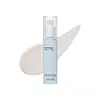GRWM Cosmetics All About That Base Makeup Prep Squad Primer Versus Etude House Sebum Soak Pore Primer
What's inside
What's inside
 Key Ingredients
Key Ingredients

 Benefits
Benefits

No benefits
 Concerns
Concerns

 Ingredients Side-by-side
Ingredients Side-by-side

Water
Skin ConditioningDimethicone
EmollientPolymethylsilsesquioxane
Propylene Glycol
HumectantDimethicone/Vinyl Dimethicone Crosspolymer
Skin ConditioningGlycerin
HumectantCetyl PEG/PPG-10/1 Dimethicone
EmulsifyingGlycereth-26
HumectantPEG-10 Dimethicone
Skin ConditioningNiacinamide
SmoothingMagnesium Sulfate
Magnesium Stearate
Cosmetic ColorantPhenoxyethanol
PreservativeSilica Dimethyl Silylate
EmollientDisteardimonium Hectorite
StabilisingCaprylyl Glycol
EmollientEthylhexylglycerin
Skin ConditioningSqualane
EmollientTocopheryl Acetate
AntioxidantParfum
MaskingCI 77491
Cosmetic ColorantWater, Dimethicone, Polymethylsilsesquioxane, Propylene Glycol, Dimethicone/Vinyl Dimethicone Crosspolymer, Glycerin, Cetyl PEG/PPG-10/1 Dimethicone, Glycereth-26, PEG-10 Dimethicone, Niacinamide, Magnesium Sulfate, Magnesium Stearate, Phenoxyethanol, Silica Dimethyl Silylate, Disteardimonium Hectorite, Caprylyl Glycol, Ethylhexylglycerin, Squalane, Tocopheryl Acetate, Parfum, CI 77491
Cyclopentasiloxane
EmollientDimethicone
EmollientDimethicone/Vinyl Dimethicone Crosspolymer
Skin ConditioningMethyl Trimethicone
Skin ConditioningPolymethylsilsesquioxane
Silica
AbrasiveCaprylyl Methicone
Skin ConditioningDisteardimonium Hectorite
StabilisingPEG-10 Dimethicone
Skin ConditioningVinyl Dimethicone/Methicone Silsesquioxane Crosspolymer
Tocopheryl Acetate
AntioxidantDiisostearyl Malate
EmollientCI 77891
Cosmetic ColorantTriethyl Citrate
MaskingSilica Silylate
EmollientCyclopentasiloxane, Dimethicone, Dimethicone/Vinyl Dimethicone Crosspolymer, Methyl Trimethicone, Polymethylsilsesquioxane, Silica, Caprylyl Methicone, Disteardimonium Hectorite, PEG-10 Dimethicone, Vinyl Dimethicone/Methicone Silsesquioxane Crosspolymer, Tocopheryl Acetate, Diisostearyl Malate, CI 77891, Triethyl Citrate, Silica Silylate
 Reviews
Reviews

Ingredients Explained
These ingredients are found in both products.
Ingredients higher up in an ingredient list are typically present in a larger amount.
Dimethicone is a type of synthetic silicone created from natural materials such as quartz.
What it does:
Dimethicone comes in different viscosities:
Depending on the viscosity, dimethicone has different properties.
Ingredients lists don't always show which type is used, so we recommend reaching out to the brand if you have questions about the viscosity.
This ingredient is unlikely to cause irritation because it does not get absorbed into skin. However, people with silicone allergies should be careful about using this ingredient.
Note: Dimethicone may contribute to pilling. This is because it is not oil or water soluble, so pilling may occur when layered with products. When mixed with heavy oils in a formula, the outcome is also quite greasy.
Learn more about DimethiconeThis ingredient is a silicone used to improve the texture of products and absorb oil. It does not get absorbed into the skin.
Like other silicones, Dimethicone/Vinyl Dimethicone Crosspolymer helps condition the skin by creating a barrier. In this sense, it can act as an emollient and trap moisture in.
This ingredient is a type of elastomer.
Learn more about Dimethicone/Vinyl Dimethicone CrosspolymerDisteardimonium Hectorite comes from the clay mineral named hectorite. It is used to add thickness to a product.
It can also help stabilize a product by helping to disperse other ingredients.
Hectorite is a rare, white clay mineral.
Learn more about Disteardimonium HectoritePeg-10 Dimethicone is silicone with conditioner and emulsifier properties. It mostly acts as an emollient in skincare and and humectant in haircare.
According to the manufacturer, acidic formulations decrease the stability of this ingredient. It works best in neutral or near neutral formulations.
Polymethylsilsesquioxane is a silicone used as a film forming agent.
When applied to the skin, this ingredient creates an invisible film on the surface. This film still allows oxygen to pass through, but prevents moisture from escaping. This can help condition and hydrate the skin. It also leaves a silky feel when applied.
Polymethylsilsesquioxane has not been shown to clog pores. It has been deemed safe to use up to 55%, but most cosmetics use much less.
If you have concerns about using this ingredient, we recommend speaking with a professional.
Learn more about PolymethylsilsesquioxaneTocopheryl Acetate is AKA Vitamin E. It is an antioxidant and protects your skin from free radicals. Free radicals damage the skin by breaking down collagen.
One study found using Tocopheryl Acetate with Vitamin C decreased the number of sunburned cells.
Tocopheryl Acetate is commonly found in both skincare and dietary supplements.
Learn more about Tocopheryl Acetate